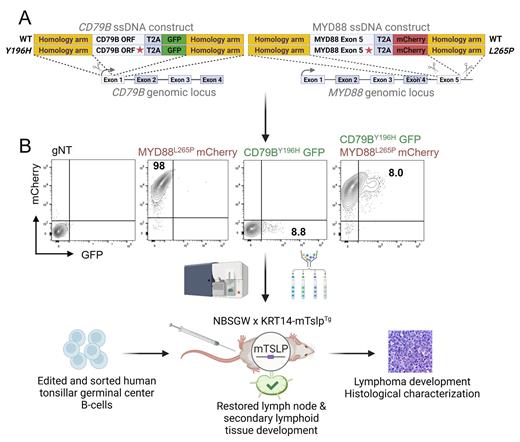Background and Significance: The clinical and genetic heterogeneity of DLBCL has led to the recent classification of the disease into five genetically distinct subtypes. The MCD/C5 subtype of DLBCL is defined by genetic alterations of CD79B at the first tyrosine residue of its ITAM motif (CD79B Y196H), crucial for signaling downstream of the BCR, and MYD88 (MYD88 L265P), a signaling adaptor protein essential for Toll Like receptor signaling. CD79B Y196H and MYD88 L265P mutations together define the MCD/C5 subtype and were found to be co-dependent for proliferation and oncogenic BCR-signaling in vitro. However, the mechanism of epistatic interaction between CD79B Y196H and MYD88 L265P is unknown. The MCD/C5 DLBCL subtype is associated with particularly poor clinical outcomes, however only a few human cell lines and a genetic mouse model are available for preclinical testing. Here, we developed a novel genetic approach to engineer the MCD/C5 subtype of DLBCL in primary human tonsillar germinal center B cells. To this end, we introduced the CD79B Y196H and MYD88 L265P mutations as genetic knockin alleles utilizing CRISPR-Cas9 homology directed repair templates (HDRT). In addition, we developed humanized NBSGW mice carrying a mouse Tslp-transgene to enable development of lymph nodes and secondary lymphoid organs to propagate genetically engineered GC B-cells carrying CD79B Y196H and MYD88 L265P knockin mutations for lymphoma development ( Figure 1).
Results: Primary human germinal center B-cells were isolated from tonsils and grown on follicular dendritic feeder cells expressing CD40L and IL21. Single strand DNA templates were designed for CD79B, with and without Y196H mutation. Constructs were linked to fluorescent reporters by T2A sites and flanked by homology arms of ~280 bp targeting the guide RNA cut site. The target site was selected to disrupt the endogenous gene, while placing the construct under transcriptional control of endogenous promoter/enhancer elements. We achieved a knock-in efficiency of 5-8%, prior to single-cell cloning and genotyping to confirm the presence of heterozygous CD79B Y196H mutant CD79B Y196 wild-type mutations ( Figure 1).
Preliminary biochemical studies show a delayed response and reduced intensity of signaling downstream of the BCR upon stimulation in CD79B Y196H mutant, compared to CD79B Y196 wild-type knockin germinal center B-cells. A similar approach was taken to design temples encoding Exon 5 of MYD88, with and without the L265P mutation, utilizing two guide RNAs to excise and replace Exon 5, linked to a mCherry reporter by a T2A site. Upon successfully introducing the MYD88 HDR templates into our CD79B wild-type and mutant clones to generate four distinct genotypes based on wildtype and CD79B Y196H and MYD88 L265P mutations alone or in combination.
In addition, traditional NSG mice lack lymph nodes and secondary lymphoid organs. Lack of lymphoid follicles in NSG mice, owing to defective IL7Rα-signaling, contributed to lack of lymphoma formation observed in the previous model. In our model, we substituted the missing IL7Rα-signal with transgenic expression of murine Tslp, which enables development of embryonic lymphoid tissue inducer (LTi) cells that are required for the development of secondary lymphoid organs and germinal center follicles supporting initiation of human DLBCL development.
Conclusion: Previous approaches to model DLBCL starting from germinal center B-cells were based on lentiviral overexpression of mutant oncogenes. Thereby, tonsillar germinal center B-cells with lentiviral BCL2 and BCL6 overexpression did not form lymphomas in NSG mice, however, were permissive to malignant transformation by MYC. Building on this previous work, we propose an improved model for preclinical testing for genetically defined DLBCL subtypes. Our two main improvements involve (i) genetic modeling based on knockin-strategies targeting endogenous loci and transcriptional control elements to phenocopy physiological gene expression levels and transcriptional regulation, and (ii) substitution of defective IL7Rα-signaling by transgenic expression of murine Tslp to rescue development of LTi cells. Transgenic expression of mTslp enables LTi-dependent formation of lymph nodes and secondary lymphoid organs supporting lymphoma development.
Disclosures
No relevant conflicts of interest to declare.


